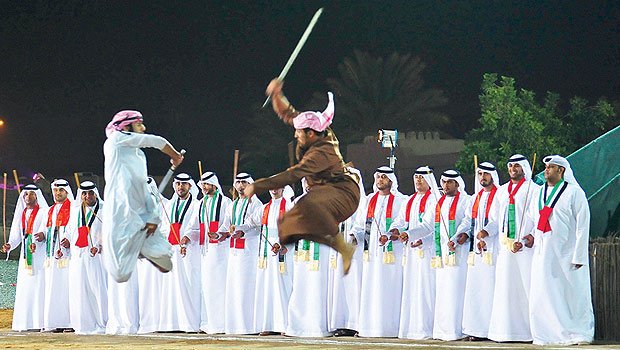In a rapidly modernizing world, the United Arab Emirates stands as a beacon of futuristic ambition. Towering skyscrapers, smart cities, and global innovations dominate headlines. Yet behind the glittering façade lies a heartbeat rooted in tradition—one that thunders through the ground with the rhythm of drums, the swish of bamboo canes, and the steady steps of men who refuse to let their heritage fade.
The traditional Emirati sword dance, known as Al Ayyala, is more than just a performance. It is a living expression of unity, honor, and masculinity, carried forward by generations of men who understand its deeper meaning. From the deserts of the past to the festivals of today, Al Ayyala continues to be a powerful symbol of national pride.
A Dance Born of Brotherhood
Al Ayyala, often referred to as the “stick dance,” originated as a war dance—a rallying call performed by men before heading into battle or celebrating a victorious return. While it no longer marks warfare, it continues to reflect the values that once defined tribal life: strength, unity, and loyalty.

The dance typically features two rows of men standing face to face, holding thin bamboo sticks that mimic swords. Between them, drummers keep the beat alive, while a lead singer chants poetry that celebrates bravery, kinship, and love for the homeland. Each movement is synchronized, purposeful, and deeply symbolic.
To the casual observer, it may look like a simple repetition of steps, but within the dance is a language understood by those raised in the culture. The alignment of the group, the height of the cane, and the tempo of the drum all speak volumes about discipline, unity, and shared memory.
Passed Down Through Generations
What makes Al Ayyala so powerful is not just its aesthetics but its preservation. In many Emirati households, it’s not uncommon for boys to grow up learning the steps from their fathers and grandfathers. These intergenerational bonds ensure that the tradition isn’t lost in the noise of modern life.
“My father taught me to dance when I was six,” says Hamdan, a 28-year-old dancer from Al Dhaid. “He learned from his father. We dance at weddings, at National Day celebrations, even at school events. It’s not just tradition—it’s part of who we are.”
While the transmission of the dance was once informal and rooted within families, formal cultural institutions have since stepped in to support and expand its reach. Schools across the Emirates now include heritage programs where students learn traditional music, crafts, and dances. Youth centers organize regular workshops, ensuring that children, even in urban environments, have access to this cultural practice.
In Al Ain, a community troupe led by elder performers meets weekly to rehearse and teach newcomers. These gatherings are open to all, welcoming both those who seek to connect with their roots and those who simply admire the art form.
The National and Global Stage
Al Ayyala is no longer confined to local villages or family celebrations. It has become a centerpiece in national events and cultural festivals, taking the spotlight during occasions such as UAE National Day, the opening ceremonies of global expos, and diplomatic receptions.
It was officially recognized in 2014 when UNESCO added it to the Representative List of the Intangible Cultural Heritage of Humanity. This global recognition brought with it an international spotlight and increased efforts to document, preserve, and promote the tradition.
In recent years, performances have been held in countries around the world, showcasing Emirati culture to foreign dignitaries and curious travelers alike. The sight of rows of men moving in perfect harmony while the air vibrates with the rhythm of drums is both mesmerizing and grounding—a reminder that some stories don’t need translation.
For many of the performers, these opportunities to represent their culture on a global stage are both humbling and empowering. “We don’t speak the same language as our audience, but they understand the passion,” says Rashid, a dancer who performed at a cultural event in Germany. “They feel it, just like we do.”
Adapting Without Losing the Essence
Like any cultural tradition, Al Ayyala has evolved over time. Today, modern interpretations sometimes incorporate choreographed lighting, stage effects, and even contemporary music elements. While traditionalists may worry about the dilution of the dance’s essence, many see this evolution as a way to keep it relevant.
“Culture is not frozen in time,” says cultural expert Mariam Al Shamsi. “If we want young people to embrace it, we need to let it grow with them. The core of Al Ayyala—its spirit of unity and strength—remains the same, even if the form changes.”
This sentiment is echoed by younger performers, many of whom have found ways to blend tradition with modernity. Social media platforms now feature short videos of performances, behind-the-scenes rehearsals, and even tutorials on basic steps. These digital expressions allow the dance to reach a wider audience, particularly among younger generations who live more of their lives online.
At the same time, elders within the community continue to emphasize the importance of maintaining the traditional format. “It’s not just about the dance,” says 60-year-old Saif, a long-time practitioner. “It’s about the poetry, the history, the discipline. You have to feel it to understand it.”
A Sacred Masculine Space
In a time when gender roles are being redefined around the world, Al Ayyala stands out as a space where masculinity is celebrated in its most communal and expressive form. It’s not about aggression or dominance, but about pride, protection, and presence.

“There’s something powerful about seeing men move in harmony,” says Khalid, a university student and part-time performer. “In Al Ayyala, strength is not shown through fighting, but through rhythm, coordination, and trust.”
This sacred space has become a rite of passage for many young Emirati men. To be invited to join the dance is to be recognized by one’s peers, to be included in a long-standing brotherhood that transcends time.
The Future of a Living Heritage
As the UAE continues to build its vision for the future—one that includes space exploration, digital innovation, and global leadership—it also carves out space for the preservation of its cultural roots. The men who dance today are not resisting change; they are grounding it.
They serve as a reminder that progress does not require forgetting. That heritage and innovation can move side by side, just as the rows of dancers do in perfect synchronization.
In every performance, from the largest stadium to the smallest village gathering, there is a message: we remember. We honor. We move forward without letting go.
And as long as the drum beats and the canes rise and fall in rhythm, the story of the Emirati people—resilient, united, and proud—will continue to be told, not just through words, but through movement.
The dance lives on.
Read More: How a UAE Book Club Is Empowering Women Across the Emirates













